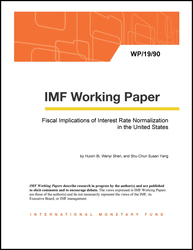
Fiscal Implications of Interest Rate Normalization in the United States
This paper studies the main channels through which interest rate normalization has fiscal implications in the United States. While unexpected inflation reduces the real value of government liabilities, a rising policy rate increases government financing needs because of higher interest payments and lower real bond prices. After an initial decline, the real government debt burden rises even with higher tax revenues in an expansion. Given the current net debt-to-GDP ratio at around 80 percent, interest rate normalization leads to a negligible increase in the sovereign default risk of the U.S. federal government, despite a much higher federal debt-to-GDP ratio than the post-war historical average.
Publication date: May 2019
ISBN: 9781498311151
$18.00
Add to Cart by clicking price of the language and format you'd like to purchase
Available Languages and Formats
| English |
Prices in red indicate formats that are not yet available but are forthcoming.
Topics covered in this book
This title contains information about the following subjects.
Click on a subject if you would like to see other titles with the same subjects.
interest rate normalization , monetary and fiscal policy interaction , fiscal sustainability , non linear DSGE models , New Keynesian model , limit distribution , active rule , debt level , bond price , government debt
Also of interest
Summary
Copyright © 2010 - 2026
Powered by:
AIDC



